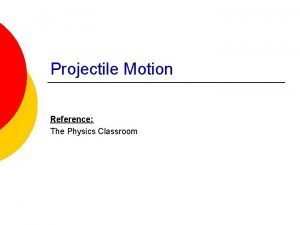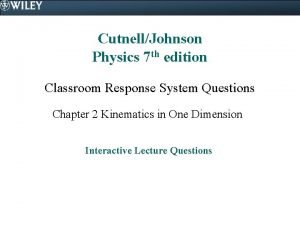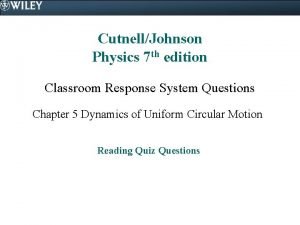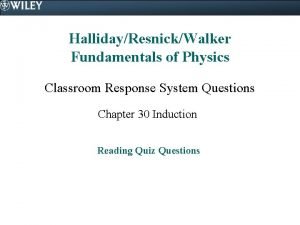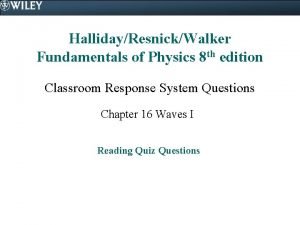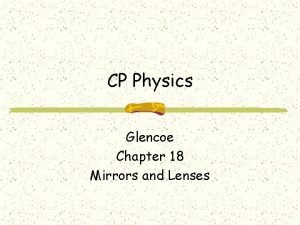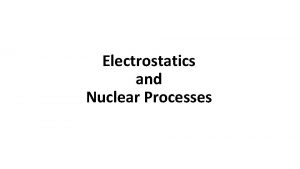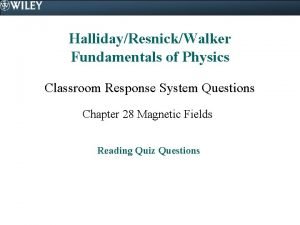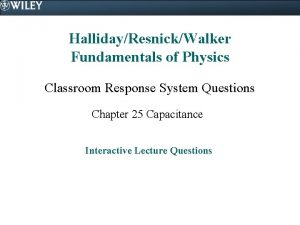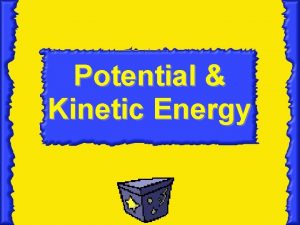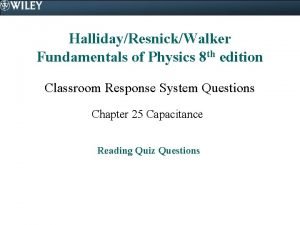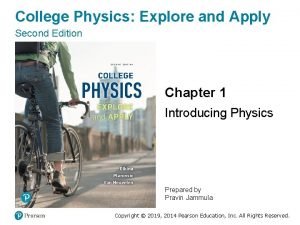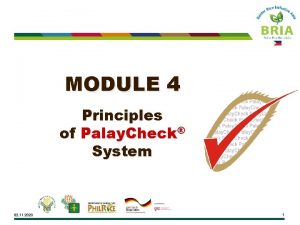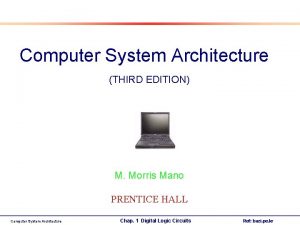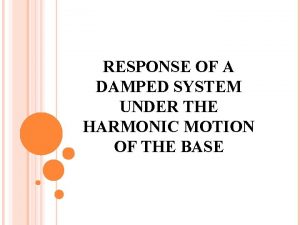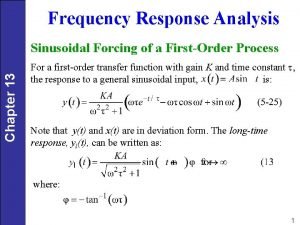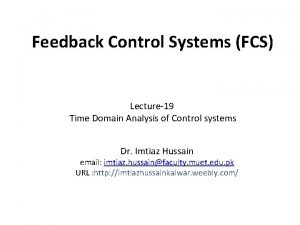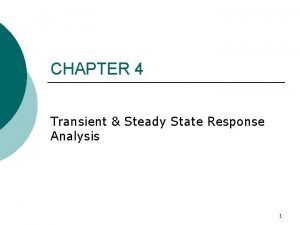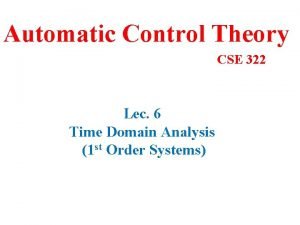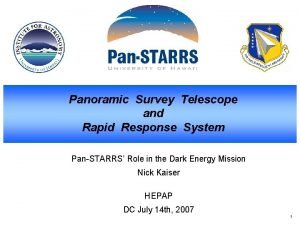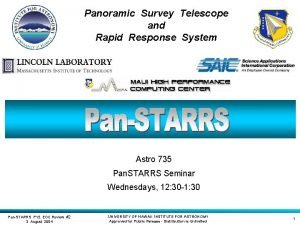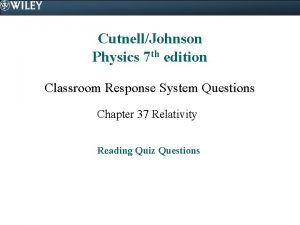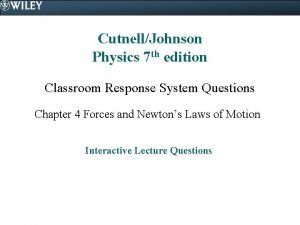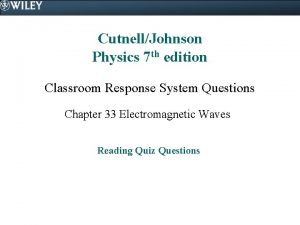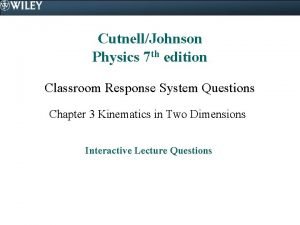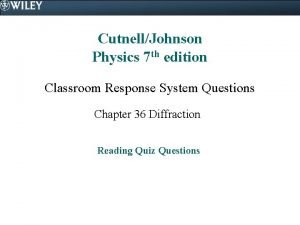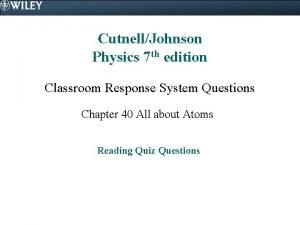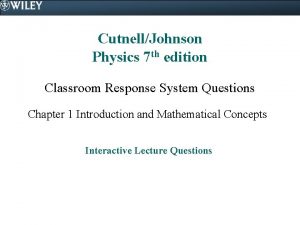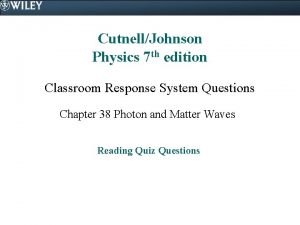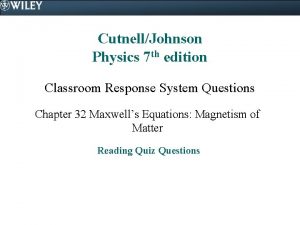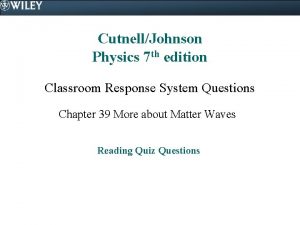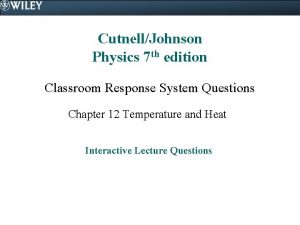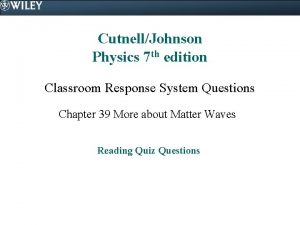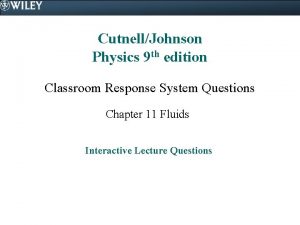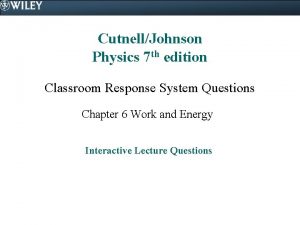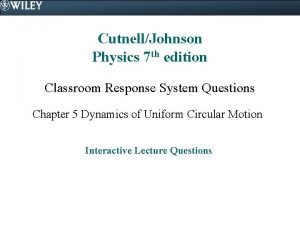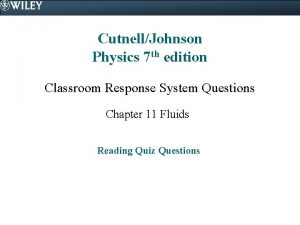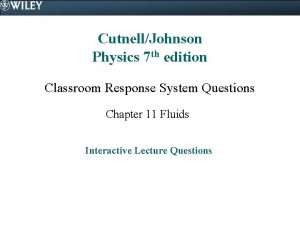CutnellJohnson Physics 7 th edition Classroom Response System











































- Slides: 43

Cutnell/Johnson Physics 7 th edition Classroom Response System Questions Chapter 40 All about Atoms Reading Quiz Questions

40. 2. 1. Which of the following is not a property of atoms? a) Atoms are put together systematically. b) Atoms combine with each other. c) Atoms emit and absorb light. d) Atoms are stable. e) All of the above are properties of atoms.

40. 2. 1. Which of the following is not a property of atoms? a) Atoms are put together systematically. b) Atoms combine with each other. c) Atoms emit and absorb light. d) Atoms are stable. e) All of the above are properties of atoms.

40. 3. 1. Which one of the following is not a quantum number? a) optical quantum number b) principal quantum number c) orbital quantum number d) spin magnetic quantum number e) spin quantum number

40. 3. 1. Which one of the following is not a quantum number? a) optical quantum number b) principal quantum number c) orbital quantum number d) spin magnetic quantum number e) spin quantum number

40. 3. 2. What are the possible values of the spin magnetic quantum number? a) 1, b) 0 and + , 0, + , and +1 only c) 1, 0, and +1 only d) 0, 1, 2, 3, … e)

40. 3. 2. What are the possible values of the spin magnetic quantum number? a) 1, b) 0 and + , 0, + , and +1 only c) 1, 0, and +1 only d) 0, 1, 2, 3, … e)

40. 4. 1. If the orbital quantum number is l = 2, what is the orbital angular momentum? a) b) c) d) 2 e) 6

40. 4. 1. If the orbital quantum number is l = 2, what is the orbital angular momentum? a) b) c) d) 2 e) 6

40. 4. 2. Which of the following statements concerning the orbital angular momentum of an electron in an atom is true? a) The orbital angular momentum is a classical parameter. b) We know of no means to measure the orbital angular momentum. c) The z component of the orbital angular momentum has no physical meaning. d) The orbital angular momentum is not related to the orbital magnetic dipole moment.

40. 4. 2. Which of the following statements concerning the orbital angular momentum of an electron in an atom is true? a) The orbital angular momentum is a classical parameter. b) We know of no means to measure the orbital angular momentum. c) The z component of the orbital angular momentum has no physical meaning. d) The orbital angular momentum is not related to the orbital magnetic dipole moment.

40. 5. 1. What was learned in the Stern-Gerlach experiment? a) Electron spin is quantized. b) Energy levels within atoms are quantized. c) Photon energies are quantized. d) The magnetic dipole moment of an atom is quantized. e) Energy levels within atoms can be split into two or more levels by applying a magnetic field.

40. 5. 1. What was learned in the Stern-Gerlach experiment? a) Electron spin is quantized. b) Energy levels within atoms are quantized. c) Photon energies are quantized. d) The magnetic dipole moment of an atom is quantized. e) Energy levels within atoms can be split into two or more levels by applying a magnetic field.

40. 5. 2. In the Stern-Gerlach experiment, a magnet played an important role. What is that role? a) Ionized silver atoms followed circular paths around the magnetic field lines in the experiment. b) The steady magnetic field provided a magnetic deflecting force on the moving silver atoms. c) The gradient of the magnetic field deflected the neutral silver atoms. d) In the steady magnetic field, the silver atoms were attracted to either the north or the south pole of the magnet, depending on the atomic dipole moment.

40. 5. 2. In the Stern-Gerlach experiment, a magnet played an important role. What is that role? a) Ionized silver atoms followed circular paths around the magnetic field lines in the experiment. b) The steady magnetic field provided a magnetic deflecting force on the moving silver atoms. c) The gradient of the magnetic field deflected the neutral silver atoms. d) In the steady magnetic field, the silver atoms were attracted to either the north or the south pole of the magnet, depending on the atomic dipole moment.

40. 6. 1. How is the nuclear magnetic resonance (NMR) spectrum measured? a) by observing the removal of protons from atoms b) by observing the flipping of the spins of protons c) by observing the ionization of atoms d) by observing the flipping of the spins of electrons e) by observing the alignment of magnetic moments of the atoms within a solid

40. 6. 1. How is the nuclear magnetic resonance (NMR) spectrum measured? a) by observing the removal of protons from atoms b) by observing the flipping of the spins of protons c) by observing the ionization of atoms d) by observing the flipping of the spins of electrons e) by observing the alignment of magnetic moments of the atoms within a solid

40. 6. 2. In magnetic resonance, protons absorb photons in what part of the spectrum? a) x-ray b) radio c) gamma ray d) visible e) infrared

40. 6. 2. In magnetic resonance, protons absorb photons in what part of the spectrum? a) x-ray b) radio c) gamma ray d) visible e) infrared

40. 7. 1. What does the Pauli exclusion principle require? a) No two electrons within an atom can have the same set of quantum numbers. b) No two atoms can have the same set of quantum numbers. c) No particle can have a non-zero probability density inside a confined system. d) Atoms that have an odd number of protons cannot combine with atoms that have an even number of protons. e) Electrons are excluded from the nucleus of an atom.

40. 7. 1. What does the Pauli exclusion principle require? a) No two electrons within an atom can have the same set of quantum numbers. b) No two atoms can have the same set of quantum numbers. c) No particle can have a non-zero probability density inside a confined system. d) Atoms that have an odd number of protons cannot combine with atoms that have an even number of protons. e) Electrons are excluded from the nucleus of an atom.

40. 7. 2. Which one of the following scientists is credited with the statement that “No two electrons in an atom can have the same set of values for the four quantum numbers? ” a) Heisenberg b) Schrodinger c) Pauli d) Zeeman e) Einstein

40. 7. 2. Which one of the following scientists is credited with the statement that “No two electrons in an atom can have the same set of values for the four quantum numbers? ” a) Heisenberg b) Schrodinger c) Pauli d) Zeeman e) Einstein

40. 8. 1. What is the maximum number of electrons that can occupy the lowest energy subshell of an atom? a) 1 b) 2 c) 4 d) 6 e) 8

40. 8. 1. What is the maximum number of electrons that can occupy the lowest energy subshell of an atom? a) 1 b) 2 c) 4 d) 6 e) 8

40. 9. 1. The subshells of atoms are labeled using letters. Which one of the following choices is the correct sequence of filling these subshells? a) a, b, c, d, e b) h, k, l, m, n c) e, g, b, d, f d) s, p, d, f, g, h e) m, t, w, r, f

40. 9. 1. The subshells of atoms are labeled using letters. Which one of the following choices is the correct sequence of filling these subshells? a) a, b, c, d, e b) h, k, l, m, n c) e, g, b, d, f d) s, p, d, f, g, h e) m, t, w, r, f

40. 9. 2. In the following notation, 2 p 4, what is the principal quantum number? a) 1 b) 2 c) 3 d) 4 e) 6

40. 9. 2. In the following notation, 2 p 4, what is the principal quantum number? a) 1 b) 2 c) 3 d) 4 e) 6

40. 9. 3. Atomic states that have the same value for which of the following parameters form a shell? a) n b) l c) J d) s e) Z

40. 9. 3. Atomic states that have the same value for which of the following parameters form a shell? a) n b) l c) J d) s e) Z

40. 1. When a molybdenum metal target is bombarded with electrons, two characteristic wavelengths are prominent in the x-ray spectrum that is produced. These wavelengths are labeled K and K. What does the letter “K” indicate in this notation? a) The characteristic lines involve the n = 1 shell of the molybdenum atoms. b) The K stands for “klystron, ” which is the radiation generator. c) The characteristic lines involve the electrons at the highest energy levels within the molybdenum atoms. d) The characteristic lines are at the long wavelength-end of the x-ray spectrum. e) The characteristic lines for molybdenum were first observed by Rudolph Karl.

40. 1. When a molybdenum metal target is bombarded with electrons, two characteristic wavelengths are prominent in the x-ray spectrum that is produced. These wavelengths are labeled K and K. What does the letter “K” indicate in this notation? a) The characteristic lines involve the n = 1 shell of the molybdenum atoms. b) The K stands for “klystron, ” which is the radiation generator. c) The characteristic lines involve the electrons at the highest energy levels within the molybdenum atoms. d) The characteristic lines are at the long wavelength-end of the x-ray spectrum. e) The characteristic lines for molybdenum were first observed by Rudolph Karl.

40. 10. 2. What did H. G. J. Mosley find to be the factor that determines the location of an element in the periodic table? a) atomic radius b) atomic mass c) number of protons d) number of neutrons e) number of electrons

40. 10. 2. What did H. G. J. Mosley find to be the factor that determines the location of an element in the periodic table? a) atomic radius b) atomic mass c) number of protons d) number of neutrons e) number of electrons

40. 11. 1. Which of the following terms inconsistent with the term laser? a) highly directional b) sharply focusable c) highly coherent d) highly incandescent e) highly monochromatic

40. 11. 1. Which of the following terms inconsistent with the term laser? a) highly directional b) sharply focusable c) highly coherent d) highly incandescent e) highly monochromatic

40. 12. 1. Which one of the following processes is necessary for the operation of a laser? a) bremsstrahlung b) beta decay c) stimulated emission d) ionization e) luminescence

40. 12. 1. Which one of the following processes is necessary for the operation of a laser? a) bremsstrahlung b) beta decay c) stimulated emission d) ionization e) luminescence

40. 12. 2. What is population inversion? a) Impurity atoms are added to the gas inside a laser to increase the number of electrons in higher energy levels than are in lower energy levels. b) Energy is added to the atoms in a laser such that more electrons occupy a metastable higher energy state than are in a lower energy state. c) This occurs inside a laser when there are more higher energy photons than lower energy photons. d) This is the photon-electron process within an atom that leads to spontaneous emission.

40. 12. 2. What is population inversion? a) Impurity atoms are added to the gas inside a laser to increase the number of electrons in higher energy levels than are in lower energy levels. b) Energy is added to the atoms in a laser such that more electrons occupy a metastable higher energy state than are in a lower energy state. c) This occurs inside a laser when there are more higher energy photons than lower energy photons. d) This is the photon-electron process within an atom that leads to spontaneous emission.

40. 12. 3. Which one of the following must be achieved for a laser to operate? a) More atoms must be in the excited state than in the ground state. b) All of the atoms must be in the same energy state within the system. c) The atoms within the system must be ionized (missing one or more electrons). d) The atoms must be under the influence of a magnetic field. e) The magnetic moments of all of the atoms within the system must be aligned.

40. 12. 3. Which one of the following must be achieved for a laser to operate? a) More atoms must be in the excited state than in the ground state. b) All of the atoms must be in the same energy state within the system. c) The atoms within the system must be ionized (missing one or more electrons). d) The atoms must be under the influence of a magnetic field. e) The magnetic moments of all of the atoms within the system must be aligned.
 University physics with modern physics fifteenth edition
University physics with modern physics fifteenth edition 2know classroom response system
2know classroom response system Btech smart classes
Btech smart classes Mis chapter 6
Mis chapter 6 Report
Report Natural response and forced response
Natural response and forced response Natural response and forced response example
Natural response and forced response example Primary immune response and secondary immune response
Primary immune response and secondary immune response Hewitt
Hewitt Physics classroom
Physics classroom Centripetal acceleration physics classroom
Centripetal acceleration physics classroom Physics hanging sign problem
Physics hanging sign problem Unit of flux
Unit of flux Electromagnetic wave in a sentence
Electromagnetic wave in a sentence Physics classroom lenses and mirrors
Physics classroom lenses and mirrors Electrostatics physics classroom
Electrostatics physics classroom Gauss law physics classroom
Gauss law physics classroom Physics classroom magnetic field
Physics classroom magnetic field Capacitance physics classroom
Capacitance physics classroom Physics classroom kinetic energy
Physics classroom kinetic energy Capacitance physics classroom
Capacitance physics classroom College physics: explore and apply 2nd edition answers
College physics: explore and apply 2nd edition answers Modern physics vs classical physics
Modern physics vs classical physics Physics ia topic ideas
Physics ia topic ideas Palaycheck system 2020 revised edition
Palaycheck system 2020 revised edition Computer system architecture by morris mano
Computer system architecture by morris mano Operating system
Operating system Operating system concepts 6th edition
Operating system concepts 6th edition Chords rule in dbms
Chords rule in dbms The american system of criminal justice 16th edition
The american system of criminal justice 16th edition Criminal justice wedding cake
Criminal justice wedding cake Interactive voice response system randomization
Interactive voice response system randomization Smart response software
Smart response software Convolution integral
Convolution integral Health electronic response data system
Health electronic response data system Sinusoidal response of first order system
Sinusoidal response of first order system Steady state response in control system
Steady state response in control system Transient response of first order system
Transient response of first order system Parabolic response of first order system
Parabolic response of first order system Panoramic survey telescope and rapid response system
Panoramic survey telescope and rapid response system University of hawaii
University of hawaii Dynamic response in control systems
Dynamic response in control systems Muscular system response to exercise
Muscular system response to exercise +audience +response +clicker
+audience +response +clicker








